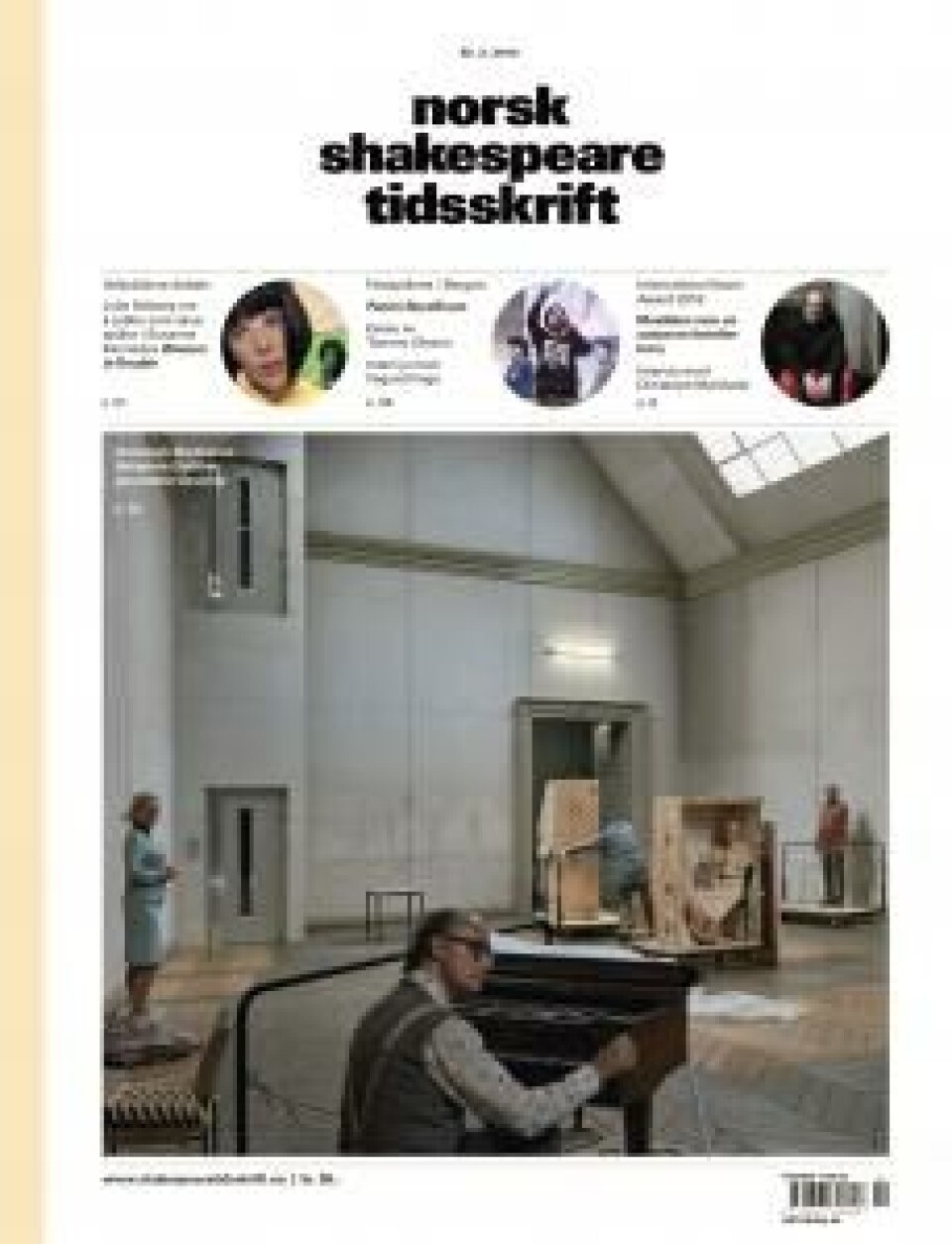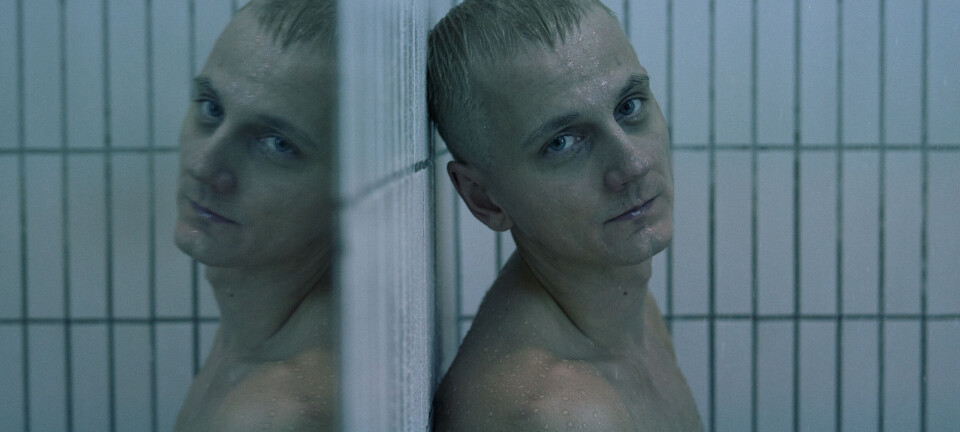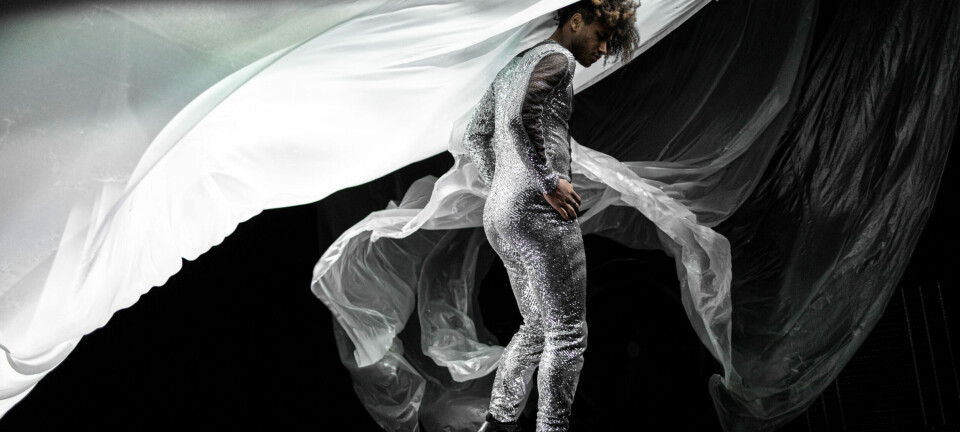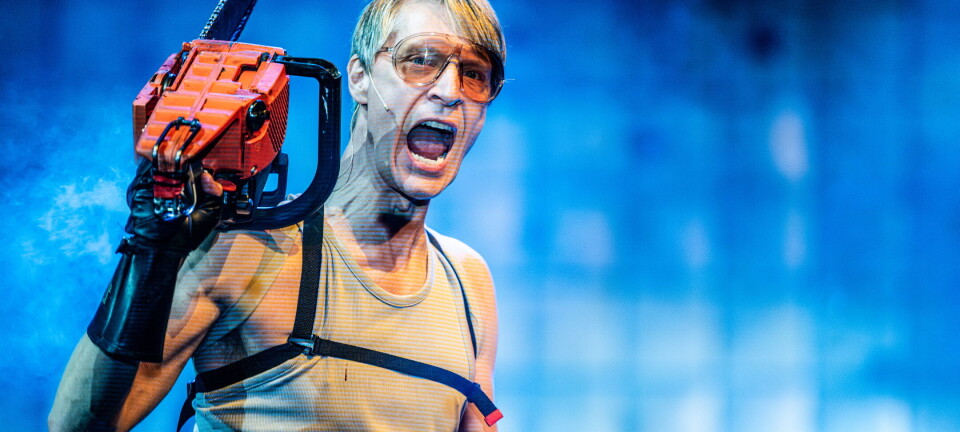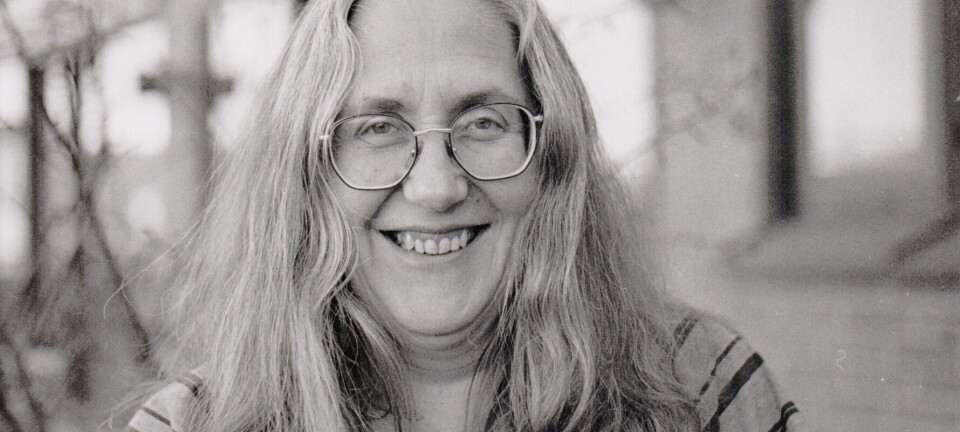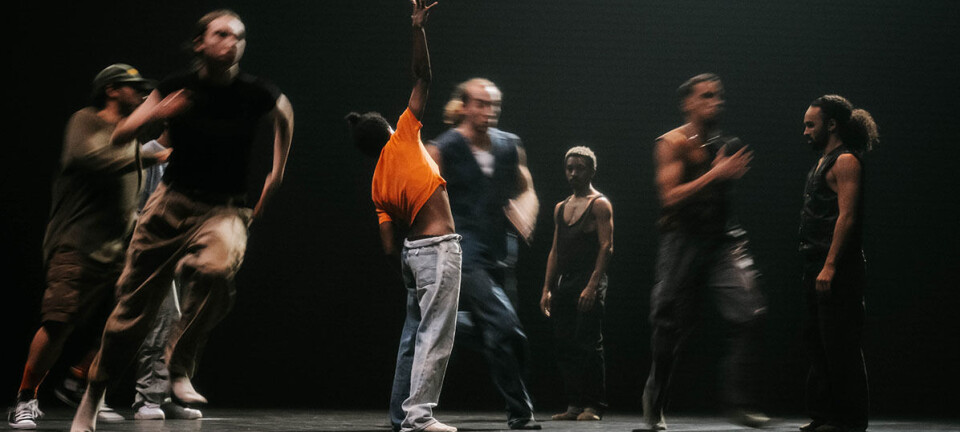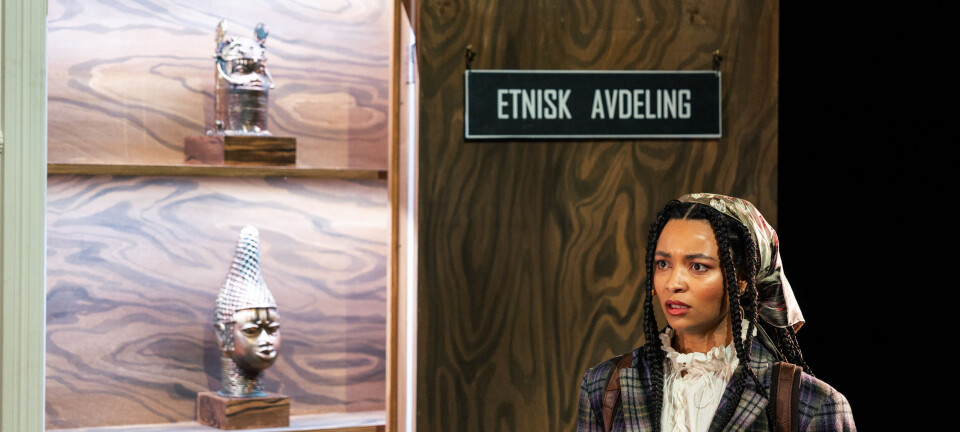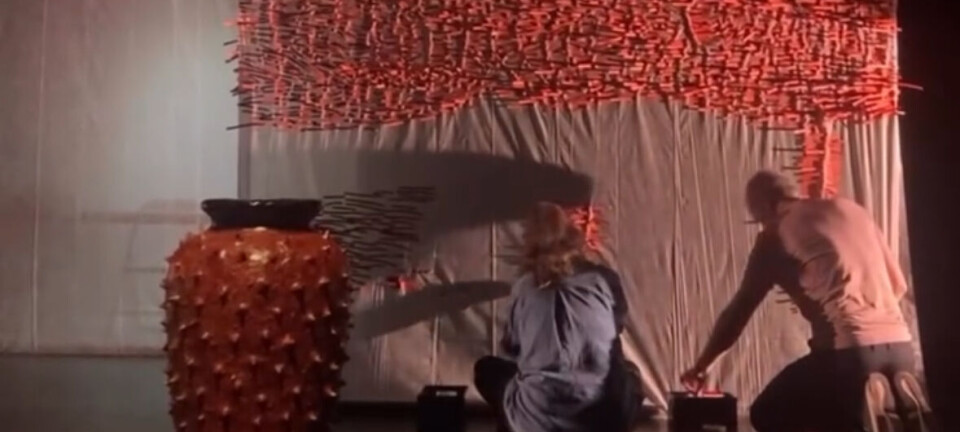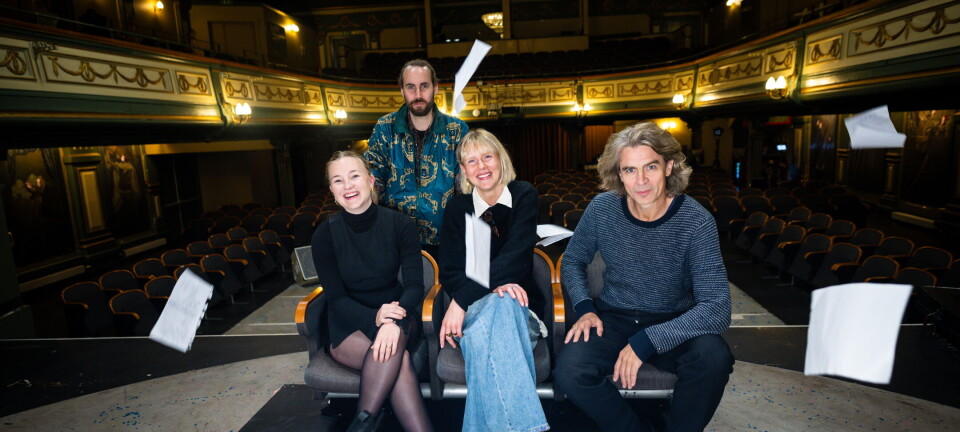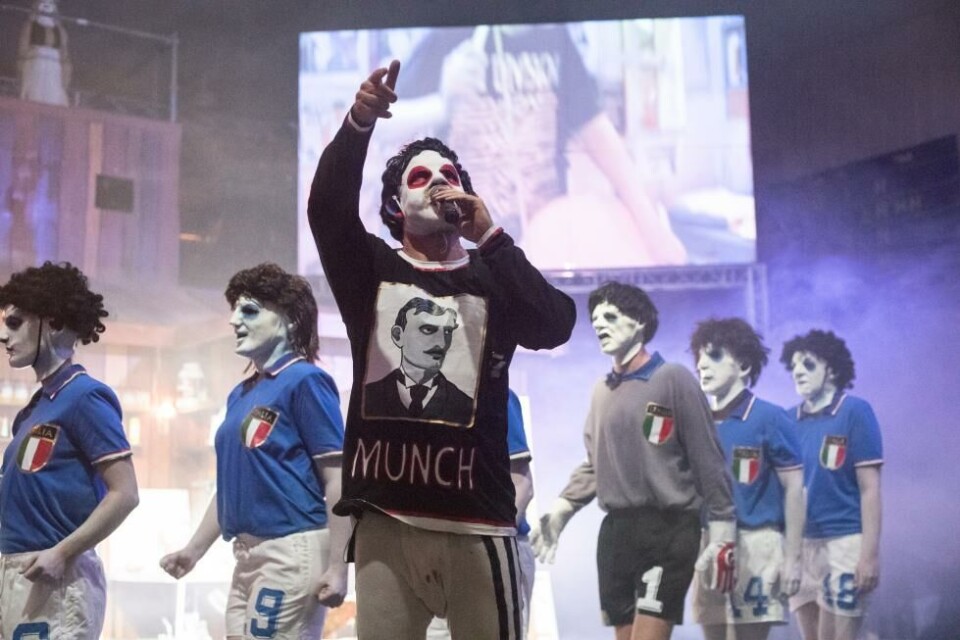
It's a Part of the Palette
14. juni fortsetter Vegard Vinge og Ida Müller sin Ibsensaga, med Hedda Gabler, på Det Norske Teatret under Heddadagene. Intervju med Vegard Vinge, fra Norsk Shakespearetidsskrift, 2018, her:
(Bergen): In conjunction with a new production and exhibition by Vegard Vinge and Ida Müller, Panini-BoysRoom, at the Bergen International Festival, Vinge sat down for a public conversation with Marc Siegel on May 30, 2018 at the Litteraturhuset. The following text is based on that discussion.
Marc Siegel: Welcome everyone. Welcome Vegard Vinge. I’m an American who has been living in Berlin for the past twenty years. By training, I’m a film scholar, but I teach in the Department of Media, Theater and Popular Culture at the University of Hildesheim. It has been a tremendous opportunity for me to be here in Bergen and see the Panini-Boys-Room. I have seen almost everything that Vegard Vinge and Ida Müller have done in Berlin, but I haven’t seen any of their work in Norway until now. We are therefore on similar ground, since many of you have perhaps seen their previous work here. We can discuss based on these different perspectives and experiences. Very sadly, Ida Müller is sick and can’t be with us today. Those of you who know their work know the intensity and obsessiveness involved in the realization of their aesthetic, so it’s no surprise that Ida Müller has taken ill after they presented this beautiful work here, a new and fresh contribution to their oeuvre, if you will. I’m all the more thankful that Vegard is sitting here with us. Vegard, I’ll begin by drawing attention to the fact that we’re sitting here talking in public. It’s something that you and Ida almost never do. You haven’t gone out and presented your perspectives on your work. You haven’t defended your work against the – to my mind – incredible misrepresentation that it some-times receives. You have allowed the work to stand for itself. That’s a very strong position. It does, however, allow myths to emerge and misinformation to circulate. It seems important to me to address that since in Germany and in Europe you are considered the most innovative theater makers of your generation – But you’re the only ones who don’t go out in public and sell yourselves. In terms of these myths, I can begin with my impressions of the newspaper reports here in Norway: for instance you’re called a «director» and Ida is called a «set designer.» For those who know your work, we recognize that as a misrepresentation. You’re a performer, an author, a painter. In fact there’s another myth, that all of the paintings and drawings we see in the performance are part of the «set», in essence are something that Ida has done. In fact, the elaborate, complex paintings and drawings on the wall in Reinickendorf, the fantastic football players in the Panini Cathedral – that’s all your work. I point this out not to attribute credit but because these categories don’t really work for what you’re doing: director, set designer.
Vegard Vinge: It’s sad that Ida can’t be here because it’s a whole thing. You can’t take away one part. It’s like with the actors or sound. If you take away one thing, it just breaks down. It’s like with Marthaler and Anna Viebrock. Probably if you take away Viebrock, the whole thing will break down. Or like when Bert Neumann died. Bert Neumann and Castorf. They built up an aesthetic together. I mean, Ida is more the director than I am. Or she has better ideas than I do. More instinct for the stage. I don’t know what is what.
MS: It seems that you each have your area of focus. But since you bring up Bert Neumann and Castorf. The way I understood that they often worked was that maybe they would meet once. Neumann would develop a stage concept and then there would be a kind of set and a redesign of the space of the theater. Castorf would then develop the pieces further in relation to that set.
VV: We have a different approach.
MS: What is that approach?
VV: Everything comes more out of images. You want to see certain things on stage. But we don’t have any conceptual approach. Of course, there are some ideas that can be intellectually formulated for a quasi application or a talk but, for me, the important thing is instinct, guts, the energy – I don’t know. It’s hard to talk about these things in such a gen- eral manner. My subjective truth is always twisting – slipping away
MS: Maybe we can talk specifically about this production of Panini-BoysRoom, and how you and Ida worked together to create – I mean, you drew the Panini images, right?
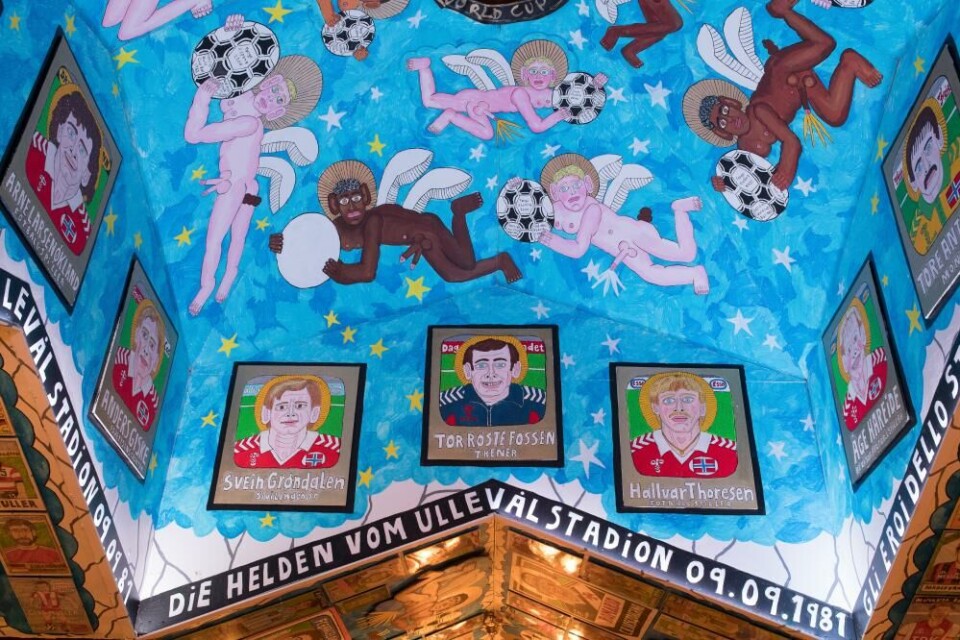
VV: Yeah, because I was more into football – Uh, maybe I can talk about – because I met Ida Müller in – Okay, first of all, I don’t believe in this talking blablabla now. I feel it’s in a way – It makes me uncomfortable – I never heard a talk that really contributed to the work. Okay. Maybe Andy Warhol, where it’s a part of the work. Or like Schlingensief, where it’s a part of the work. But mostly it takes away – Most theatermakers are not necessarily philosophers, intellectuals, even if everything now seems to drown in a theoretical Überbau. That’s maybe your fault, the academics, but of course everybody needs a job. But I prefer the unarticulated. There is for me no Erlösung on this side of words. We want to have the mystique. We have the masks and you don’t want to see the people behind, because we’re boring, as everyone is similarly boring. In a way you want to have a place to project onto. I remember I met Morten Har-ket, you know, the singer of A-ha. I had a poster in my room. And I was like, «Wow, Morten Harket, singer of A-ha.» You have this projection. The idol. He’s like a father fig-ure or whatever. And you don’t want to meet
them. When you meet them in public, it just takes away the whole magic. That’s the problem – because you want them to be – Michael Jackson was really good at that. Because he had his Neverland. He had the reality and the fiction. Bigger than life.
«I prefer the unarticulated. There is for me no Erlösung on this side of words»
MS: But he paid publicists. He paid press agents to create a myth around him and to talk to the press. I mean, I agree. I don’t want to-
VV: Because he was an art figure. And I’m like a normal person, like the rest of us. And that’s why I don’t understand – When you work, you go into certain spaces and you try to find aesthetics that open up and can communicate some subconscious shit – Something that’s bigger than yourself.
Okay, a little background information: I met Ida Müller when I was at the Norwegian Opera because I was very into opera music. She came as a set assistant from Germany. I think I was Hospitant at the Opera, because I didn’t know what I wanted to do. But I liked opera so I wanted to be a part of it, with the singers. There I met her. She came with a German director. I remember, at the premiere party I gave her a book. I gave her A Doll’s House. I wrote in there, «We’re going to do A Doll’s House and we’re going to revolutionize theater.» Then we started collaborating together. We were doing A Doll’s House in a small theater in Oslo, at Lars Øynos Grusomhetens Theater. He is special. He is obsessed. He goes for it. We had some cultural fund money. We had some actors. And we tried to do it like – We never had any idea how you do theater. Okay. You’ve seen lots of theater things and you try. Okay. «You come in this door.» «You come in that door.» «And you speak a sentence.» «Then you speak a sentence.» And all those things. But then you feel like, «Ah, it doesn’t function.» And then you think, «Oh, what if you paint the door? The door looks so boring.» Then you try to find – In a way, we used the whole rehearsal time just to find an aesthetic. And it felt too weak with walking on stage. It has to be more [demonstrates a stylized walk]. Maybe if you come from com- puter games and comics, you have other places to draw from. But then we made a piece. I mean, A Doll’s House was on a stage in this small theater. The actors, they didn’t want to go with how the flow was throughout the rehearsal. We had to say to them, «Hey, take the money from the cultural arts and have a nice time.» That was a few days before the premiere. Ida and me and the scenography assistant, who was 19 and had never been in theater before. So we were alone and in trouble, and I said, «Okay, the assistant has to play Nora. And Ida plays Ivar and Emmy and I play Bob.» And then I was also Helmer. Because we knew if we didn’t do the play, we’d have to pay back the money to the Art Council. And we were like, «Fuck, this is really shitty.» But we didn’t really rehearse – We had 1, 2, 3 days. We were so nervous. We couldn’t tell anyone we were doing this show. We just had to do it and invite the Art Council. So we didn’t have any poster. We didn’t send out any messages. In a way, that made it very protected. We felt pure shame and ready for disaster. But we started really small and protected. That’s so important, not being watched and judged, because you can’t save it. I really don’t believe in schools. So in a way, you could just follow your instincts. I would never do this here. I don’t even want to do it now. But my problem is now I don’t believe more in the pieces. I felt we had done something. I had really believed in art. But then you put it on a stage in an institution or in another cemented structure. And then it always comes, «Oh, it’s too long. 8 hours. You can’t play longer than 8 hours.» Or it’s this you can’t do because that’s too dangerous. Or that you can’t do – and then you feel, «Fuck, it’s not my play.» I am not in charge, the administration takes over. I mean, it’s the limits and then the scandalization on top of it. Oh fuck, it’s so boring. Now I feel like – you have to build your own structure, your own playground, your own rules. And that started in Reinickendorf last year. It was the first time we left –
MS: The theater?
VV: [points to man in audience] That’s my father again in the audience. With the same gesture [puts hand on side of cheek, holding up head] He always has the same gesture when he’s watching.
MS: But Vegard, what you’re describing sounds to me –
VV: But does it make any sense? I feel like I’m just blabbing away.
MS: I can tell you the sense I got out of it. But let me just say that our talking is not about demystifying the work. It’s about demysti- fying the false information about the work. That’s a different perspective. At any rate what I notice in this development that you just described is that you started out working on a play, doing a different interpretation or a different way of approaching a play. You’ve moved along and shifted your focus to a kind of institutional critique, like we know from the art world, where you call into question not just the play, but the players, the theater, the space of the theater, the ticket takers, the publicity machine, the jury that makes decisions about who gets money to do their work, the application process, etc. You’ve left the space of doing innovative interpretations of plays and you’ve moved onto confronting a larger construction.
VV: But first of all, we never did an interpretation, like in the sense of a clever perspective, a new understanding of the piece, wanting to open up people’s eyes and these things. For me, it’s more about using – It’s about this dna. Let’s say, I can write a book. I go down the street and I watch the sky and the trees. And I try to do some classic writing. Then I read some books and I feel it’s written better there and it’s written better there. So anyway, I think, why don’t I just take these sentences there. That describes my thing. I just cut it out and I put it in. Because I’m not coming up with a better sentence. And I’m not interested in the sentence. That’s just a sign, a letter in an alphabet for a possibility of a new narrative, where colors, movements, sounds are as important or more than text. Everything is signs, icons. But I am trying to reach for something behind, something that can only be reached unconsciously within the duration of the show, if we are lucky. So the sign for me, or a sentence, it’s very clear. It’s like a sample.
MS: But you often come up with a better context for that sentence.
VV: Different. I don’t know if it’s better. In a way you’re more using these – Let’s say from A Doll’s House, you take five sentences from Nora you find interesting. But I didn’t even find five sentences from Nora interesting. Or maybe when she talks about Bob and Ivar and Emmy. So I just found these few things I thought were interesting about the play. So it’s not about that I wanted to show that Nora is leaving at the end. Everybody knows this. It’s more about – I mean, the framework of Ibsen and these plays. It’s more about Norway and national identity and wanting to be a part of – You know everybody has this longing for success and being a part of the system, reaching the top, the applause. When we were in school, it was always this guy singing the main role in the school revue and then he went to the National Theater and played a big part there. Even if I don’t believe in it. It’s so coded in your body. You know, when have you succeeded? My mother, she won’t come before I’m at the National Theater. Sentralbadet is not enough for her. It doesn’t have the seriousness – The smell of success. Unfortunately, I can’t even smell it myself.
MS: Well, I don’t think –
VV: No, I was thinking, what more can you do. You’ve been working a long time. Last year was with Nationaltheater Reinickendorf and you made a 120 hour play. Built up a set for six months. And people watch 2 hours and have an opinion about it: good, bad, like, not like, pretty, ugly, dinosaur terminology, categorization. We have to transcend the categorization. Humanity being reduced and put into banal boxes. And the structure. It’s about doing the interview to sell some tickets, or the graphic bureau making the posters, or the private life of the stars, and they cut down on rehearsal, or nothing is there, so we need some dramaturgs to write a big program book with more quasi intellectual blablabla to cover up the nothingness. I – Yeah, and then you have to have a talk at the Literature House. The factories are closed down. No work in traditional industries, so we have to create all this thing around curators, programmers, the art world. [gestures to Bergen Festival banner] Someone has to make this. And it’s just about these things. But you totally feel you are losing yourself. There’s no substance to grab on to.
MS: And you fly in an American to talk to you.
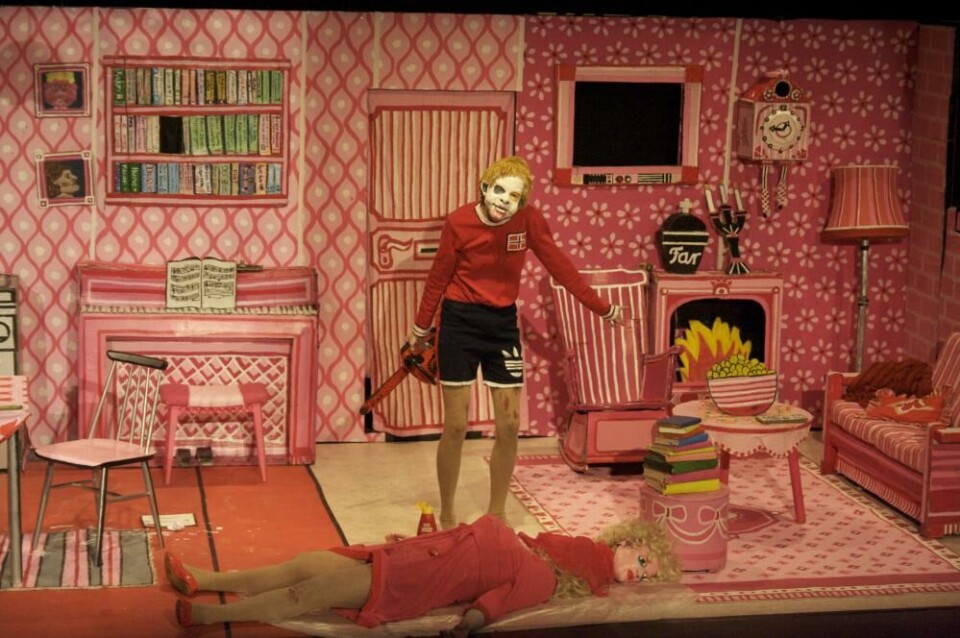
VV: Yeah, yeah. Or you cling to the screws and the wood in the scenography.
MS: But you wanted me to come here. [Turns to audience] He wanted me to come here.
VV: Yeah, because I knew you needed money. And you’ve never been to Norway.
MS: I have to say Norway – I’m sorry to say, but Norway was not really on my map until I confronted your work. You’ve put Norway on the cultural map in Germany and in Europe because of the way in which Norwegian references are mixed in with other kinds of pop references, from A-ha to Ibsen to Munch (the boy’s Munch T-shirt which I only noticed for the first time in this production). You kind of Norwegianize a kind of cultural production. No matter what you’re doing, there’s this base of Norwegian references that may remain somewhat unclear to some viewers in Berlin. I was thinking about what you’re doing. You’re not doing Ibsen. You’re giving us a world that is created by Ibsen characters. It’s like, what would Ragnar Brovik’s room look like? What are his fantasies? What do they look like? What would he draw?
VV: This is a Ragnar Brovik show. Because Solness, Baumeister Solness. He built Reinickendorf. You know, the National Theater is a big one. He wants to build a new house, a structure. Ragnar Brovik: he’s just in depression modus. «Ich tauge wohl auch nicht.» Those are his only sentences. But he wants to do something. And he came here with his sat- ellite project and did it here in the Sentralbadet. In a way, even if it’s a failure, it’s okay because ich tauge wohl auch nicht. You know what I mean. But Baumeister Solness. He’s more about building structures, and building – But I wanted to say, this Ibsenizing or Norwegianizing. For me, it’s more like signs. In the end, it’s not about the «door» sign or the «Ibsen» sign. It’s more about the Eingeweide. You know, the shit.
MS: The innards.
VV: Yeah, because everybody can – in a way it’s all about this. All the other things are built up around to create the narrative. Of course it’s more like a child’s – You create stories and these things. But I find it’s about, you know, the body, to create an honesty. We did The Wild Duck here in 2009 and I remember we were so nervous. Because we built – That time we really had time to rehearse and we had all these building blocks. We had scenes. We had like scenes for 200 hours. We never do a run through. We just rehearse scenes. Then we came here to Bergen. And it was like, fuck – We tried to– In a way we didn’t know how long it was also. You start on the theater voyage. And so it was in a way my fault that it became how it was. So long. It just need- ed all this time with the characters and the themes. We just thought, «Okay, we have to start with the first building block and just see how it goes, into unknown territories.» It’s about dynamic. To keep you mentally alive through the run. Maybe you have one building block and you put the next one after it. It’s like a set list. But if you put «Take on Me» after «Take on Me.» Then you feel, like, fuck, I have to have more dynamic. These songs are too high energy. And you see it in the show and think we have to just change. To get out of certain scenic dead situations.
MS: And you make these decisions, right? You recognize the dynamic and –
VV: Well, no. But it’s also work with Trond [Reinholdtsen], the composer, who we mostly work with. He is a music genius. He’s not here now because playing in Bergen was such a spontaneous decision. But you have to have people around who feel it, and are tuned on to the same aesthetic, ideological modus, hehe. Who know, «Okay, now it has to go down or up or just stay» – Now, we came here and it was such short notice. I couldn’t bring most of the gang. This is more of an adhoc thing. But I find it brings another quality. More free and raw. Not possible to be too arty. Or good. What I wanted to talk about was this anxiety when we came to Bergen last time and everybody was hating us. The press was hammering. And you’re standing there. And you probably think your own thing is shit too. But that’s why I never invite people. I can understand why people don’t want to see it. Why should I defend the play. Because you go into certain areas. I can understand if people don’t want to see it. Or if they say, I have better things to do. But I’m happy that someone liked it and I’ve been able to go on. But I wouldn’t say you have to come and see it.
MS: Maybe we can talk about the shit a little bit. Because that’s often one of the only things in the paper when we read about your work. I mean, in Germany you get amazing reviews, get featured on the covers of Theater Heute and Theater der Zeit. But there’s also this kind of scandal. I mean, I know you don’t read about your work.
VV: I read sometimes, until Bergen last time, and then I just stopped reading. Because there were such negative things and then you totally lose your self-confidence.
MS: I can only describe my relation to it. Maybe I can talk about the piss first. I remember seeing The Wild Duck in the two week presentation in the windows of Prater. It was 24 hours a day. People could come and go as they pleased. It was free. People just walking down the street would stop and look at it. Even there, is that theater? It’s a differ- ent kind of performance or installation art, if you will. There was one scene where the father enters a room and harrasses the son. The phone keeps ringing for, like, ten minutes. The son repeats a line, something to the effect of «You never understood me. You don’t understand me.» The father says something like, «I have to take care of my finances.» I’m sorry I can’t remember the exact lines. But then another son comes in, the character played by you, and lies down. It’s this kind of stasis, a scene where father and son can’t communicate. The second son comes in and lies down, in a fetal position but on his back. He begins twitching a bit, pulls down his pants, and suddenly begins urinating, with incredible virtuousity in his mouth. And it’s at the same time disturbing, dirty, and perverse. It’s also incredibly moving. It seems to comment on this inability of father and son to communicate. It’s like a figure for this narcissistic stasis of the son. Aesthetically, it’s absolutely beautiful. It’s this incredible fountain. And because you use so much stage blood, the fountain is pink. This yellow-whitish fluid that goes into your mouth, it comes up pink. That was an overwhelming emotional experience for me, and I’m sure I’m not alone. But I don’t see such perspectives on your use of bodily fluids and excrement recreated in writing about your work. Instead, I see things like «Oh, he pissed in his mouth again.» Or, «Oh, he shit.» And I can talk about the shit too and the ways that it affects and impresses me.
VV: Okay, I can talk about this. I mean, it was something with Bergen. I don’t know where this thing comes from. In Bergen, there was so much anxiety. In a way we had so much Angst. I remember Torbjørn Davidsen was there with us. He was playing with us. He was standing by the curtain. I came to the curtain and he is so Zen. But then there was just so much anxiety and it just came. Somehow the body just takes over. It’s not a planned thing. For me it’s not about transgression. Because you know maybe the Vienna Actionists in the 1950s or ’60s did all these things. It was probably then a transgression. For me it’s like a part of a palette, like a painting palette. You have a cardboard shit when you want to express something that has a function at 50 meters in an opera setting. You have this one to express something another way. I’m trying to make compasses. Like you have to have one kind of acting style. Maybe Robert Wilson if you want to express this type of movement. Then you go more into an Otto Mühl way when you want – It’s about the situation and the context. It’s the same way with the music. You have 8 bits, then you have this computer game and you have karaoke, the more midi versions, and then you have the original ones with the full orchestration. And it’s the same as with the colors. You have green and you have red. Maybe you have – In Reinickendorf you play in the forest. And the shows are so long also. So we can’t just have one aesthetic, one level. You need to change gears. Let’s say you have two hours in the forest and everybody is sleeping in the audience room. Then you have to wake them up. Maybe you have to change the whole palette. Or go complementary. Maybe you have to go to red. A hard cut, from green. You know, «Oh, it’s so red.» Or you have to go from 8 bit sound to full. It’s more about how to use this whole palette. And everything is a part of this alphabet, you know. And it’s more about using – And the shit and the piss. It’s not like, «Oh now it gets crazy.» It’s like a sample also. But it express- es it in another way. And I don’t know. Maybe it’s a little bit Angst. It’s about Angst and when the body takes over. I find in a way that it’s a healthy cathartic moment. For me, it was that, at least in Bergen in 2009. Because when you start to break down, you get saved by – It’s not lying. And then it got taken up later as part of the formal palette.
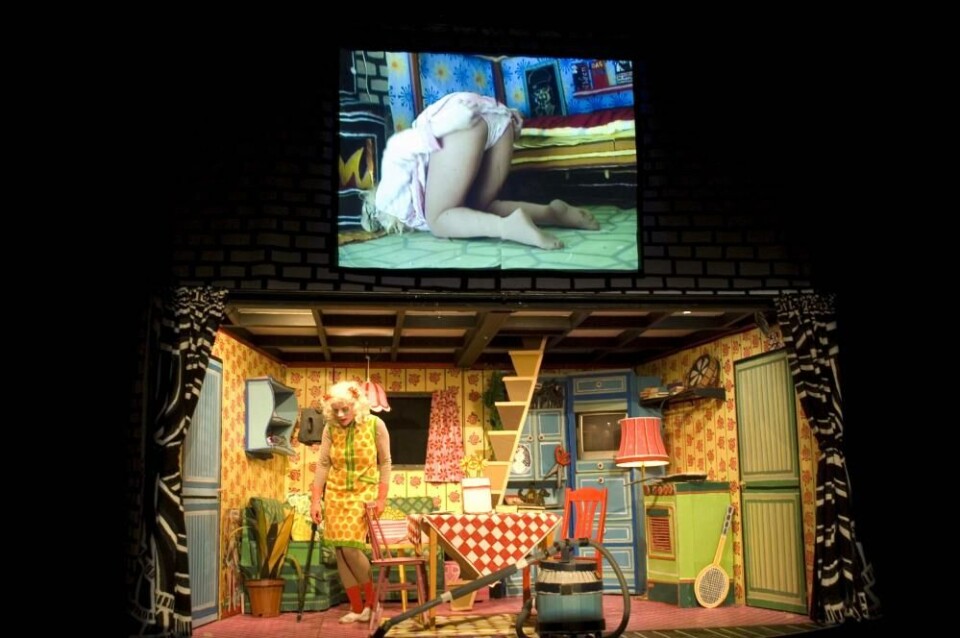
MS: I thought it was interesting in the performance I saw a couple nights ago that you shit very early on. It wasn’t a climactic moment. It wasn’t there to be a shock. It was a similar situation to what I described with the piss. This time, it was the mother at the kitchen table with the son on the floor. Then, the child started shitting. It seemed like he was just incapable of dealing with this familial situation any other way. I don’t know about the meaning. That’s a separate issue. But the shit established a kind of aesthetic for this piece. We have the brown. We later see a melting Snicker’s bar that you paint with which becomes the brown. There’s chocolate pudding later on, the typical kind of shit for stage characters. They don’t usually have organic feces be- cause that comes from human bodies. That’s why I like you calling it a sample, because it’s coming from outside the artificiality of the world you create, like the quotes that you use.
VV: Like Paul McCarthy. It so funny because I was at this discussion at the Volksbühne and they were talking about Günter Brus and all this Vienna Actionist stuff. They were say- ing, «Yeah, it’s this transgression. But today it does not have a function.» And I was like, «Heh?» I mean, now it’s part of the palette. But, of course, it has a function. It’s an archaic, still important necessity. The urge to do it, part of it – is like when people come with – perspective, the move from flatness to depth in painting – you know, they had a breakthrough in how to paint in a way. And they give this to future painters, so they can use this method. For me, it’s the same thing. The Wiener guys have given something, like part of a palette. And today, at this time, when you can’t really breathe, because everything is so. Yeah, everything is like this [reaches over to festival banner with logo]. Everything is high gloss and you’re trying to behave when you go into the street. All the design, the cleanliness: it’s antiseptic and it forces a reaction. And you see it more and more in the whole internet. There’s this urge out there. But there it’s probably kind of out of control, you know, with the industry. I mean, I wish it was a part of the palette and I can teach about it in theater schools. [Laughs]
: [Laughs] I’ll invite you.
VV: I’ll give all these courses, these master courses.
MS: Why can’t you? I mean when Günter Brus, who you get compared to, when he shit and pissed in the Art and Revolution event in 1968, it was a provocation in Austria of the stuffy atmosphere, the Nazi past. It was directly meant to be a provocation. It wasn’t material to be used. But with you – I don’t see it as a provocation. Of course, some people feel provoked, because they’re uncomfortable with that –
VV: It’s like a genre also. I mean, you don’t go to a Tarantino and get provoked and say, «Oh no, they’re not sitting in a New York apartment and talking about intellectual questions, like in Woody Allen.» It’s a genre. And in theater, even if you do it this way or that way or that way, everything is under the same label. And they don’t think in genre. I had some people who said, «It’s not enough blood.» This, they can criticize. Because the first show [of Panini-BoysRoom] I couldn’t even do the ass painting. I was verstöpft. [Laughs] And then you can really come and say, «Hey, I want my ticket back because» – [Laughs] For me, it’s a genre thing. And everybody’s like, I don’t like this or I don’t like that. But there has to be an openness for everything. I look at Marthaler, Robert Wilson, Richard Foreman, Castorf and all these different – You know, I appreciate everything. As long as you find one Schlingensief, one Meese, you find beauty and inspiration all around. That’s nice. You can see one moment there and feel «Wow.» But this, «I don’t like this, I don’t like that,» I find that strange. That’s why in a way I find media problematic. You don’t want to have media there. Because in a way you want to go into the research. You don’t want to have it out in public. People just take something out of context and just put it out there. I find, it’s dangerous. Theater is for me like a space, four walls, and you go in there. It’s a last resource where you can do this. You go into things, things that are problematic, not pleasant. And you see things coming out of you and you think, «Oh fuck, what does this represent?» That’s why I leave all the shitty scenes in because it’s like we have shitty scenes also and that’s important – or whatever.
MS: Some of your references here are theater. And, again, I know that the context of your work is theater. But what you’re doing within that context is questioning the very idea of what theater is. For instance, in the Panini-BoysRoom – for anyone who hasn’t seen it yet, I urge you to go and look at the exhibition. For me, that’s an essential part of the work. You even make it clear that it’s essential, because you invite audience members into that space during the performance. When someone sees the piece and then walks through that cathedral, that incredible installation, they recognize that it is not just a set. I’m not actually just looking at a set that serves the purpose of maybe dramatizing the action or being a location for action. It’s an installation. Ida Müller has created what one, in an art context, would describe as «an installation with paint, cardboard, and other objects.» That recontextualizes the performance. For me, it’s the best kind of installation, because when I go to museums and see something like a dirty rag lying on the floor next to some objects, I think, «Heh? This is an installation?» And I hear, «Oh no, there was a performance here the other day and this is what the artist produced.» And it just leaves me cold. But what we see with you is both an incredible performance and an installation that in and of itself is an overwhelming, engaging aesthetic experience. That’s why I question returning always to theater terminology with such categories as «set design» and «director.»
VV: What’s the focus when you read a performance? It’s always like you have the actors in the front. How the flow and timing – I remember when I came to Berlin and I saw Anna Viebrock. You were in this room. And I didn’t understand German or anything. And I was like, «Wow!» Just being in the set, the room, and the texture. You know, and Bert Neumann, the different material he used. And with the actors and the costumes and everything. For me, it starts there. Why can’t they just talk about – There are no descrip- tions of the wallpaper. Maybe the truth lies in there, the handpainted wallpaper pattern. Because they stand on stage and they talk about capitalist critique and blablabla and all those things. But that’s just words. And I’m sitting here too and blablabla and lots of words. And you can question me. But in the end, it’s about the act. Like if this was the poster for the show [grabs festival banner with logo] and then you have sponsorship from Mercedes Benz. And now you see it on the posters and then you go into the show and it’s like capitalist critique and it’s full of Mercedes Benz logos everywhere. We are all caught in that shit. That’s why in a way you have to start with the poster. I think that is okay. For me, the Volksbühne was really important. Because it felt like it was one show going on for like twenty years. It was a holistic way of thinking. Art was in every part of the production chain.
MS: Because of the design that LSD did – Bert Neumann, Lenore Blievernicht – with the posters and publications and space. So it was also a kind of complete institutional critique, rethinking theater.
VV: For me, it’s not a critique. I don’t like say- ing I want to do a critique. It’s more like the Kantine. How does it smell in the Kantine? Maybe there’s more truth there than in the piece in itself. That’s why the poster on the wall outside or how you communicate with the press is part of it. You can’t separate. But now it’s just about doing Gastspiele. Go on tour. Sell. Fast. For me theater is the last place – That’s why I find that for instance here. This is a very short possibility. We talk for about an hour. You and me, we don’t have time to really get into things. It’s just like blablabla and you work through all your points there on your paper. Theater is for me like a place. It digs down into the city and in space. I didn’t even need to go in to the Volksbühne building and watch a show, because it’s like, it strahlt. It was sending all the time. You felt that it was sending. When you walk by, you felt that something important and interesting was happening there. You said to me that when we were in Prater we closed it down. We were painting. We were still painting. And the paint sends out onto Kastanienallee.
MS: That’s another myth. I read that you were kicked out of the Volksbühne, when in fact they asked you to continue 12 Spartenhaus, but you decided not to do.
VV: It wasn’t that we didn’t want to. We couldn’t. Of course, we wanted to play. We had been fucking building and painting the installation for one and a half years and then we had to take everything down in one month, without anyone seeing it. Do you think we found that funny? It was a fucking horror. Castorf and Neumann were re- ally supportive, but the technical boss and the administration took away all our support and invented some bullshit about a threatening Feuerlöscher to make us look crazy and dangerous. That’s the problem today with the curators, theater managers and Theaterburokraten. It’s just about money and power. They want to control the art, make it easy and sellable. But you can’t control art. It al- ways finds new ways, reflects something deeper, darker, more uncanny. So the artist has to reclaim space and take control again, as United Artists. For me that’s the most important topic. But we should just talk about that next time. It’s the last frontier.
MS: Okay. With this production here, there was something so nice about it, because there was something freer. There’s something freer and more relaxed in the use of the aesthetic that you and Ida have developed, an aesthetic that is being copied by so many theater makers in Germany. I mean, Ersan Mondtag has said that all of the theater makers of his generation are living under the influence of Vegard Vinge and Ida Müller. This is incredible praise.
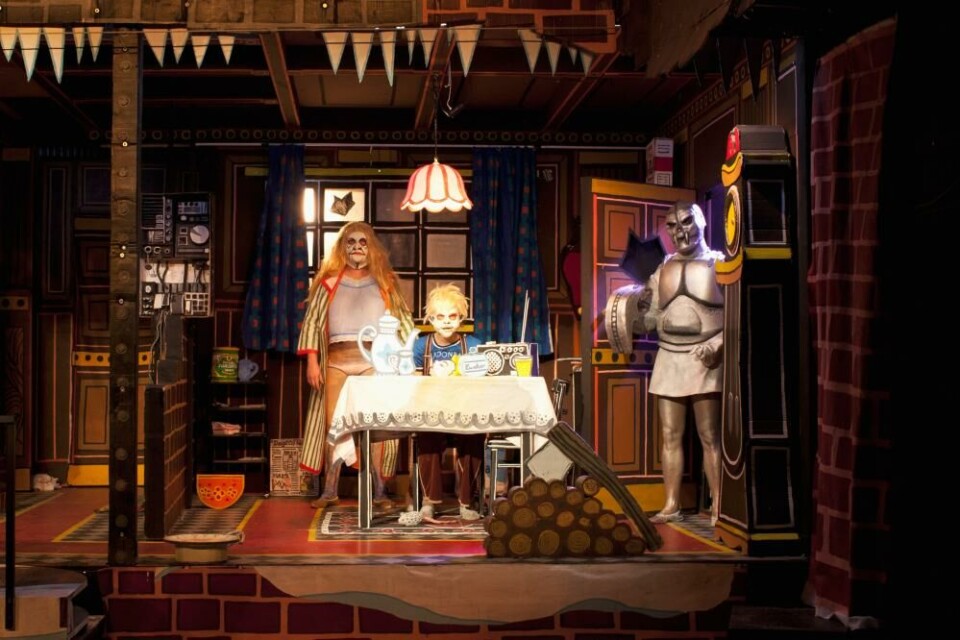
VV: [pointing to Marc Siegel] He’s my pr manager.
MS: Okay. We see the masks, we see the synchronized movement. We see some kind of comic book references. But I don’t think we always see the same neurotic precision with which your company works with synchronization of movement and sound. Here you were much freer. You were almost strutting your freedom across the whole length of the Sentralbadet. There are moments when your great performer Ida Müller, as the boy, plays soccer against the entire Italian team. This was an incredible moment because suddenly in the midst of a free, anarchic multimedia event, this brilliant virtuosity emerges and a synchronization of sound and movement come together. But you were telling me that you’re sick of that.
VV: No, no, no.
MS: You want to destroy that aesthetic.
VV: No, I don’t want to destroy it. When we started it was so neurotic. It comes out of a fetish and formal urge. I remember, we rehearsed five weeks just opening the door and going [makes footstep sounds]. Then the movement of brushing your teeth. All the details. In the first Doll’s House in 2006, it was really a neurotic thing. Ibsen’s Ghosts which came afterwards was also really set. Everything came after another. Every scene. And also The Wild Duck, the 17 hour version in Black Box Theater in Oslo. That had a set list. Then when we came to Berlin we did this Wild Duck there for two weeks. That was the first time when we thought, «Okay. Let’s just take the elements and improvise with them.» It was something freeing. Because you start to get more and more – You compete with your last show. And you become more and more Robert Wilson in a way. And you don’t want to end up like a production machine, even if he was one of my heroes.
MS: You don’t want to end up stuffy and boring like him.
VV: No, I don’t mean that. But in a way you just take the aesthetic and you can just mass produce it. And it becomes the method. And you can have your assistants do a scene in that way. That’s not healthy, I think. It becomes dead. So, in a way you have to crush your- self. I don’t know. It wasn’t a conscious thing. But I felt this urge to just rip things apart. But then you want this moment of Götz Friedrich opera, where it rises like an opera movie. You want these moments. But then you want, you want a whole spectrum. You want to have the extremes, the dynamic, the levels. Maybe it’s not healthy too. I can just see things in black and white. Maybe it’s like a child. Like you need to have the poor guy in the poor clothes. Ordnung and clarity, a fairytale, no chaos. And you want to have a rich one as the contrast to the poor, a conflict. Like you want to have Chinese represent this one be- cause you can’t have two Norwegians in the same play. The dynamic between them is too boring. Their white faces. It’s too similar. On stage visually, you want, like Nora is Chinese and Helmer is African. And the boy is – I mean, even if there’s no logic in it. Because I want to see more dynamic in it. It’s like Han Solo in Star Wars working with a Wookiee, talking with an elephant in a bar.
MS: So, dynamic as in different histories, different references.
VV: Yeah, but I mean visually dynamic also. MS: But that’s what I thought was so interesting here. That even when it’s all a bit freer, there are still these incredible moments when everything comes together, like a few nights ago with Tosca. There’s this great scene when Toscaisupontheroofandweseeherona live video projection. And your character sud- denly shifted the dynamic and said something like, «Spotify. Change the music. Change the music.» So there was this chaos, a kind of uncertainty about what would happen, a shift in dynamic. The Italian footbal team is play- ing and you call Cavaradossi, the tenor, to get ready for Tosca. The tenor starts moving, thinking he has to change his costume. At least, that’s what I thought, because he begins to leave the stage. But then your character says, «No. Stay where you are.» And then an incredible moment emerges, that is both discontinuous – You have Cavaradossi singing his love aria to Tosca, «E lucevan le stelle,» but he’s directing it at the Italian soccer players. And Tosca is on screen. Because these are performers who you’ve worked with for a long time, they have a virtuosic skill at syn- chronization. But there’s also a striking discontinuity between the situations of the two characters. But it’s still Götz Friedrich.
VV: Sometimes it comes together. But this show here is totally improvised. We don’t know where we’ll start. 5 minutes before take- off, I decided where to start on the theater chessboard, which side to work from. Okay. So sometimes you have these moments where it’s rolling for hours and sometimes it’s just like shit. It’s just stopping. We are not able – You’re searching for the energy, finding a way for things to come together. But in gene- ral the reality is that in Norway or in Europe, there are no more rooms to rehearse in. They have money and all that. But you don’t have any rehearsal spaces. It’s fewer and fewer and fewer. So it’s impossible to develop an aesthetics. Now the format has become so big. This is a small production in a way. So, in theaters, the concrete thing, you need to develop an aesthetic, hammering and sewing. And you have to try things out in a room and a space. Now you don’t get the possibilities anymore. There are no spaces if you don’t have your own institution. So, in a way you can just go into conceptual art. Because this materializa- tion for me is theater. Building worlds. Playing god. Being the gamer. We have this other group in Norway, this Verdensteateret. You know they’re building with steel and doing these detailed, highly complex things. They didn’t have any room. They can’t go on if they don’t have rooms and the support. Okay. Or then you have to reduce to a small installation on a table and film it or whatever. That’s a real problem. Okay. So we’re trying to use the situation as good as possible here, when we have a stage. Test things out. But in a way there are no rooms and spaces. And that’s the challenge, like a football team without a field. And even last time I was in Bergen, this Theater Garage. They tore the place down 9 years ago and they still haven’t got a house. It just becomes like you can just do this virtual theater. That’s why I started this video thing. Because I was thinking that I can’t even get a space any more to do things so I just have to find a new medium.
MS: And drawing or painting. But that’s why it’s been so incredible and culturally innova- tive that you’ve created your own spaces in Berlin, in part because you’ve had resources.
VV: Yeah, «had resources» is correct. But it’s nothing when you think about the size of it. In Berlin it was still cheap and there were a lot of spaces. In Norway, it’s so difficult to get anything. Everything is transformed into luxury apartments. And we have our ensemble, most of whom are Norwegians. But out of economic and space issues, we had to de- velop it outside Norway, especially when you are searching for more Wagnerian/Vigeland dimensions. But, geographically, where does Norway start and end? We are ambassadors, playing with the flag on our chest. [Laughs]
MS: Of course, we’ve only mentioned a couple of your performers. But it’s only because you have this great group of people who you have worked with for so long that you were able to put something together so quickly for this production. These people know how to react.
VV: Yes, yes. But I find this problem of space to be a really huge issue. Okay, maybe you have to go to the north of Norway, to an abandoned submarine bunker. It doesn’t matter where you are, because today people will fly there or travel with submarine. That’s globalization. And it’s easier with communication. People smell it. The new audience. So maybe it’s just about finding a place where you can develop the work. I am Fitzcarraldo. I am Kirsten Flagstad. I want my opera house.
MS: You went to Reinickendorf in Berlin,
a place where most people don’t usually go to see theater. You worked in this Halle, this factory area, and you created a whole scene there. I was there for four of the ten performances and I met people from Finland, Norway, Hungary. You created a different social scene around this unexpected space.
VV: That’s for me the quality of theater. It has to be in a place and you have to dig down in- to the earth and put the roots out. It’s not a travelling product or something to buy on Amazon. That was Reinickendorf. We used six months to build up the set there. We used four performances before it started rocking. It was really a hard start. And we were thinking, «Now we’re ready to go. Now we have the whole structure, everything. The mechanics are there.» And then we had to tear it down, after 10 performances. It was absurd in a way. Now, it’s in containers, ready for the awakening, Hamlet, The Musical, Part 2.
MS: Yeah, that was a crime. It would have been the perfect antidote to what happened in the Volksbühne, if someone – I don’t know, the Haus der Berliner Festspiele – would have continued to pay your rent, because there was a developing scene there. There were other artists who you invited to use the space. It became a whole new structure for theater, performance, music, the arts. But Vegard, there’s so much we can still talk about. But would you like to take questions from the audience?
Question: I have a very general question. I’ve seen The Wild Duck here and John Gabriel Borkman in Berlin. But I wonder what is your feeling about the audience, the spectators? What is your relationship to us?
VV: I love the audience. But it’s a schizophrenic love. I remember the first show from John Gabriel Borkman in Berlin. The last three hours there was just one person left in the audience room. The technician from behind was saying, «Hey, you have to close down the show.» But for us, I can do it without the audience. Because you’re trying to find a structure. It has to be fun by itself also. But there was this one guy there. That guy was him [points to Marc Siegel]. And I was like, «No. No. There is still one guy in the audience. Don’t close it down.» Because for me the shows are also rehearsals. They are possibilities. Because you’ve built it up. Now I wanted to rehearse there in Sentralbadet. But they have this exhibition. But now we have the set up and everything and you really could start working. Normally, we’re just using the entire rehearsal time: drawing, working, just to get the set up. But then suddenly you see people sleep in the audience. And it’s these long shows. People go out and they come back. It’s like you’re having a party and you want them to stay. You hope they’ll stay. Of course, you get sad when people are leaving. At the end, I often feel there is this community. The people have gone through something together. The audience is a huge part of the show. It’s beautiful. You want to give them everything, the painting, the set. And it’s also their tax money, so it’s justified. But the mechanics of it in itself are also very interesting for us. Because sometimes when the audience comes in, you start to want to please them. So it can tip in both directions. And you become the pleas- ing clown and forget the research.
MS: I think they’re also very generous per- formances, both in terms of the amount you give in terms of time, energy and detail. But you also give us watermelon, chips and, here, you gave us hot dogs. I don’t mean that su- perficially. I see it as a sign of you involving us in a kind of sensual event. There’s some- thing very generous –
VV: It’s like you have this ship and you invite these people onto it. Okay, so a lot of people reject it and they leave. And you have to get through it. I mean, why do you go on stage? You want to be, «Hey, look at me?» in a very narcissistic way. So in a way these rejections – You have to deal with yourself. I remember shows where everybody left. But with the audience – In a way you just want it to go on. That’s why I want to have a house, where it can mechanically go on for a year. For me, that was the Volksbühne. It just goes on. 26 years of Castorf and these people. If you were depressed, you could just go there and watch something. Sit there for a couple hours and just feel not so alone in the world. And if you want to find something, it’s beautiful. And then you can go home and do vacuum cleaning and come back maybe. For me it’s not necessary to see the whole show. It can also be an hour. Because everybody has this sense that theater is a product. It starts here and ends there. But in a way I want it to start two or three hours before the audience gets there, just to get warm. Find the energy. You want to get images. You want to try to find something. To score great goals and do breathtaking dribblings. You want to have this oper- atic moment, when the audience stands up, cheering and the image comes like this, like a wave. But mostly it doesn’t happen. But sometimes – [Laughs].
Q: I thought that something weird went on at the end [of Panini-BoysRoom]. As a member of the audience, I get what you’re saying about you and your group doing everything to pull the audience through. Part of this kind of audience experience is that it’s normal for there to be dips in people’s attention. Then at a dip when everyone was getting hot and bothered and needed to be aroused, suddenly the singer came and stayed on, and you never came back. In the end, everyone left. Did something go wrong? Was this a good point to stop? Or did you just crash?
VV: This show has a time limit of, like, five or six hours. That affects the situation. The show started really tough. It was – I don’t know why it took off that way. But I felt like it was a nice finish with Marius Drogsås Hagen. To end with his great music. Something upbeat, positive, the Bergen night. But we would have started up again. Because the journey is addictive for us, the search in itself. Let’s say in a normal show we would do, we would probably have ten hours more. So in a way you can start building things up again and go in new directions. Here it was not possible to do this. Yeah, you can go out partying for three days in Berlin but you can’t do theater for twelve hours. It’s really strict. I feel audiences these days, they want to have – I mean, they watch television series, The Sopranos, that are six seasons with Tony Soprano. You want to have this community for a longer period and connect and get the body into it. And it’s something with our reception. You go to a techno concert and it’s like, «wo wo wo,» and it builds up for ten hours. That’s why I was thinking – Everyone talks about modern theater and it has to be modern and blabla bla – What is this talk about wanting to be modern. Every brain gets formed by the so- ciety it is born into, and the technology or non-technology – If I watch computer games my whole childhood, it does something with my head, with how I receive the world. So when I want to have something on stage, I need certain things. I would have problems, probably, reading the detailed script with all the words, the black letters on white. When I see Sprechtheater or hear it, I sit there and think, «Oh, it’s too much text. It’s going too fast. I can’t take it. I’m not able to process it, to understand what every word is about.» Maybe there are people who are good at pro- cessing all this text. That’s why for me a good thing – I keep referring to the Volksbühne be- cause that’s where I really met – I was never interested in theater before I went there and saw a show. It was for me like opera. I didn’t understand anything, you know, like in opera if it’s in Italian or French. Each actor had their own speech pattern, rhythmically. There were different voices. High, low, thin and thick. They were so set, like opera voices, bass, soprano, mezzo, etc. That was readable. That I could take in.
MS: You’re speaking again about dynamics, I think. I find it very difficult to leave your pieces. The world that is created – Here it was Ragnar’s world and in Reinickendorf, it was Solness’s world. The world that is created is so energizing, disruptive, disturbing – and so erotic in ways I didn’t know I could expe- rience. I feel like I want to explore more potential because it opens up in so many direc- tions. But some theaters put limits. I felt that the dynamic of coming down with the singer the other night and the shift of focus from the front to the back of the audience worked somehow. I didn’t really expect the curtain to open anymore because it felt somehow right in terms of dynamics. But I can understand if others wanted to see more. But some theaters put limits.
VV: Some? Every theater puts limits.
MS: Borkman was twelve hours
VV: That was the limit. We were stopped there. Then we got the word from the house, «You can only do twelve hours.» We played in Black Box, the 17 hour Wild Duck. That’s the only time I felt we can play, go a whole journey. That’s why for me, what we did in Reinickendorf. It was ten shows. And in a way I wanted that everybody had to see all ten shows. Because it’s like a journey. The first show didn’t function at all. The set was not built up. It was jammed, the scenography. And the actors were in a knot. I couldn’t play them. Okay. It’s like you’re in this corner and you can’t get out and get the machine working. So it took like three shows. But then people may say, then why don’t you – But it’s even not about the show. Because people can come in and say, «Oh, I appreciate the painted chairs and the painted walls.» I don’t have problems that it’s not working, because I find that interesting, the work, the need to get out of the situation. But you can’t plan it. You have to search for perfection. You do want it to work. That’s why I need to find another form of presenting it. To find a concept for what it is now. It’s like the monster in Frankenstein or like theater cancer. But here I felt it was liberating. It was ok. Because you start to get neurotic about the form and the piece. It felt more about the moment, being in a room together. It wasn’t like I wanted to shoot myself after the show, and that’s nice. But maybe if you start getting relaxed, then maybe it’s finished. Maybe you just have the ten years and then it was finished. So now it’s finished. [Laughs]
MS: But that’s why I find that you’re not giving us a play. I mean, there are variations when you go and see a play in different performances, but you pretty much know you’re going to get a play. But you don’t give us a product. We rarely know what you will show us at each new performance. We, as audiences members, are invited in to watch your evolving process.
VV: I remember now what I wanted to say. This was the 8th part of the show, the saga. The first part of this saga was in 2006, with A Doll’s House with this Ivar character who is the same character as this one. It was Gregers in Bergen last time. It was Ragnar in Reinickendorf. It was Erhard in Borkman. It represents the boy. You know, you have the Mother. Sometimes I feel that I played that part and I think that everybody has seen everything. So I don’t need to do – Because, you know, everything reflects, the past on the present and the present on the past. You have to see it as a saga. So maybe it’s a bit unjust in a way. I wish I could just show the whole thing, like the Nibelungen. Because then I find that it really gets the perspective and suddenly something is very virtuosic. We have done some things that I think are really virtuosic. And this [Panini-BoysRoom] is something else. It’s like a television series and the characters are just morphing. That’s why – Ragnar, this boy. We started one night with Hamlet, The Musical. Because it was about depression. And Ragnar’s depression morphs into Hamlet’s depression. We’re going to do Hamlet, The Musical as a full production. It will come next year. It’s because the Ibsen world. It’s always the house. It became for me realism. And I felt it has to get flatter. It has to be another aesthetic, that is the fiction. Hamlet, with the castles: that became more fictionalized. The drug had to be more intense. It wasn’t working for me anymore. You have it in South Park. You have the South Park community. And they have this aesthetic inside the television of Terence and Philipp. They are moving very choppily and just farting. So, they have another aesthetic inside the universe. And I want to try to find another – to find something more pure and concentrated.
MS: So that’s what Hamlet was in Reinickendorf ?
VV: Yeah, but I wanted to have more cut outs and go even flatter. Because for me this whole universe of Ibsen has become so totally real- ism, like Second Life, like my reality. And I don’t like it. For me, it is not artifical enough anymore. I need a stronger aesthetic dose, need to get it further away from reality. The total and radical fiction. That’s the Leitmotiv.
Q: I was wondering about those limits you mention. I wonder, because they know you. They know who you are and then you have six hours, you have ten hours. You’re a really famous director in all of Europe. And these limits? Are they helping you or is it just annoying?
VV: Well, then you start getting older. So in a way you’re happy you don’t have to play so long. I can’t blame it on the limits. But in a way I wish there were no limits. Like here, we have a limit of 6 hours and now things start to develop. But I don’t know if I would use it, if I had power and could go free all the way.
MS: But do the limits help you?
VV: I don’t need the limits. I feel when it’s finished. For me, with The Wild Duck in Bergen, I was not finished. And in Oslo, it was finished. But Borkman, on the first day, it was total chaos. But, on the last show, the twenty-fifth, it felt good. Like now, the mechanics were there. You have tested out the limits of this universe. And in a way, now, it’s finished. You don’t need to do it anymore. So there is a point of finishing. Everyone says, you don’t finish. But it’s like a painting, you know. But it’s very – This Wagner thing, the Nibelungen. He took twenty-six years to write it. Now, how can we think in these perspectives? Today, you would never build the Kölner Dom. It takes like 600 years. You think, «Oh yeah, let’s build the Kölner Dom. I will start and then my child will take over. And in 600 years people will see the finished work.» People don’t think in these terms. Everything has to be collected immediately – In a way, you just have to start. To have a rough thing and start wide. And maybe in 20 years, it’s finished. But if you start small, like everything has to happen within two hours, then you want to find it. It has to start with unconscious cha-os and a big bang, beyond established methods. Sometimes you want to give the audience something so that it is a finished piece. But I’m trying to think in 20 years. Then you can judge it. And then all the elements are – Like Tolkien or something. [Laughs] Or Walt Disney.
MS: Vegard, since you brought up Wagner, may I just ask about the boy? I’ve noticed an evolution in the T-shirt that he wears. It’s al- ways the Burger King cap, I think. We’ve seen the Wagner T-shirt. Here, and in Reinickendorf, we saw the cover of Joy Division’s Un-known Pleasures album. We also saw Munch here. Is it Joy Division because he’s depressed? The depressed teenager?
VV: That sounds intelligent. [Laughs] I don’t know. But Munch is probably because of this Edding 3000, Solveig, the Erlösungsfrau, not a woman but a comforting creative tool. This marker. The only thing that really waits for you is the pen, you know. I’m interested in making Munch, The Movie. Especially now because everyone makes these movies about these hardcore characters that were once real. Being watered down and played by a handsome Hollywood star. Fuck. The limits for transgression in reality are just completely taken away. We can just watch the old time warriors in a movie theater, reduced to soap cliches, edible, digestible, where Kirk Douglas cuts off his ear. It’s simulacra. It’s harmless and doesn’t have Konsequenz. That is okay, but not risking anything today, not even in art, is crazy and dangerous. Like I want to make Otto Mühl, The Movie. Like today, they take Van Gogh or people with crazy destinies and they get this Hollywood star playing it. But I like this Vincente Minelli film with Kirk Douglas. It’s great, because it gets beautifully perverted, the contrast.
MS: Lust for Life.
VV: Because it’s so fucked up. The aesthetic compared to his reality, to his real life. Then I find it interesting. But now they’re trying to do this thing of playing his life. Like when you go to a shop and you see Edward Munch bags. Everything just gets taken in, reduced, made harmless, sellable. That’s why in the last show I wanted to make 120 mass production Tosca posters to give away. Everything has to be merchandise now.
MS: Mass production ass paintings?
VV: Yeah, you know. Like Campell’s Soup in a way. But I didn’t have enough paint. There was a breakdown in the communication from the back. So I want to do Edward Munch, The Movie.
Q: I was interested in your concentration when you’re playing. What I saw was a performer, director and, like, a dj at the same time. Some- times it seems like you’re really losing yourself in the play. At other moments, you’re watching everything that goes around and giving these cues. Sometimes you went up to talk to the technicians, like you were starting new sam- ples. How does this work in your mind when you’re performing? Do you ever lose yourself completely? Or are you always in charge?
VV: Maybe it’s like Kantor and others, who were doing it from the sidelines. I’m more interested in American football where you sit like this [puts fingers to his ears as if wearing earphones]. And you’re, like, the coach and you have your strategy out in the field. And you communicate with them in trying to get the ball through. Here, it was bit complicated. This was a new team in a way. They didn’t even know the classical pieces. I was, like, «Tosca» or «Vissi d’arte» and they didn’t know what I was talking about. So I had to go and do it myself. The frustration sometimes is transparent. And it’s the character. It would be perfect if we were, like, one body and it worked smoothly. Probably terribly boring also.
Q: But it had a great dynamic.
VV: Okay. Then I’ll do it that way again.
MS: I’ve heard from some of your performers that even though you have an intense concen- tration focusing on the dynamics, that there’s never a sense that you’re out of control. We even see that when you work with your shit. It’s not like you’re throwing shit everywhere. It seems always limited to only you. Maybe one or two other performers. Perhaps that’s clear in advance that it could happen. I just mention that because the way the German and Norwegian press will refer to you: Der Theaterbeserker. They make you out to be some kind of beast and that when we get into the space with you, you’re going to destroy all the people around you, and throw shit and piss at everyone. But I feel like there’s an incredible concentration and focus about the way you use your materials and move around, even if it seems violent at times.
VV: Yeah but that’s like – Let’s say you have a party. And you know your home. You know where the sofa is and the rooms in your house. And you buy some drinks. And alcohol is there and the potato chips are there. And you have your records. And you see all the people coming in and you notice. You have to – For me it’s about the energy. Trying to find the energy. To get the dance going. So that things are, like, rolling. It’s also like a chess board. The elements in the room are painted into the set. When Ida’s playing, she doesn’t do anything. She’s really thinking, «Okay, I’m going there, I’m going there. And then I’ll stop here for a while and I’ll do this.» And she is carried by sound and the other elements. Everything is really focused. It’s not like, «Oh, I’m in this wild thing.» We’re trying to make it very neutral. It’s more like signs. Of course, sometimes you let some private issues out. Like a cadence, like in a violin concerto. Sometimes it can start to – The last show it started, the rhythm started a bit too high from the very beginning. You present an aesthetic, a universe. As long as you see some audience at the end, you think, okay then some people stayed.
MS: I also see an evolution in your use of video. There’s a lot of video in contemporary theater, and a lot of live filming. Often, it seems used to show spaces on the set that the audience members can’t see from their position. So it’s even a bit more illusionistic, it adds to the illusion. But your live filming pro- duces further – It extends the world of the piece and then you feed it into new pieces. So some of the live filming from Reinickendorf gets used here in a slightly different context. That seems to me a new way of working. You’re using live filming and video to create new material.
VV: I didn’t like the use of video when we started with it. I don’t like the medium that much. Because I like to have the smell. I like to have the texture. I’m totally into movies. I have about 4000 dvds at home. I watch dvds all the time. The flatness. I don’t believe anymore in the movie theater, how it is anymore. Now there’s 3d. Let’s say, I was Francis Ford Coppola and I went out in the Philippines to make Apocalypse Now. And I could come back with the material and I could just build a movie theater for this film. And I could cut it live. I could start in a ho- tel room with Martin Sheen. Then I feel like I’m going up the river. One evening, I could go in another direction with the movie and go into the jungle with the tiger or something. Or I could stay in the village that just got bombed and follow the woman who just got killed and lost her daughter. Or I can go all the way up to Marlon Brando at the end of it. Because I find something fresh with this. Something of a search, not calculated. It happens now. It’s a risk-like sport. To feel the fragility. Now, everything is a product. I think it’s an urge for people to have the work, to feel the work. Even with these bands touring around. I wish Depeche Mode had their own club in London and over the years they could just build the club bigger and bigger and more and more labrythine. It’s like creating these Disney Worlds. This Disney guy created these Disney Worlds and you go into his universe. It’s like a search for everybody to have their own Disney World. Every per- son’s an artist, and it’s true. That’s why it’s nice to go to people’s homes. Everyone has their personal fetishes, their Disney Worlds, their unique touch.
VV: The filming started because we were at the Volksbühne and, of course, the cliché was these video cameras. So, we thought, okay, we have to have the cliché, to use it as a sign. But at the beginning we didn’t know what to do with it.
MS: But you figured out your own way to use it. Because even when I would see it at the Volksbühne, it’s used to give us some insight into some space and action that you can’t see from the audience perspective. In a strange way, it adds the illusion that the performance often breaks with. The illusion comes back in the video. But with you, we don’t just get images of spaces we can’t see. It’s creating new spaces. It’s forging the Depeche Mode world, creating a new visualization, new ma- terial that you then explore further and incor- porate into your next work.
VV: I don’t know. It’s more instinct. That’s why this is hard for me to do. Now I can reflect on some things. But mostly I’m just trying to follow instincts. I’m not trying to follow a conceptual path – And the audience is more intelligent. Yeah, that’s why I like the audience because they are more intelligent than the people behind it. It’s more about creating these signs and they do the reading. If you start understanding it yourself, it becomes too flat. If I start understanding my own thing, then I’m going in the wrong direction. I often try to deal with these images where I don’t know. Even if you feel embarrassed about – Or you feel like maybe this not expressing something good. There are a lot of these signs that are really dark. You also feel a responsibility with these things. That’s why I find that theater is maybe the last place where you can do it because it’s still 100 people in a room. It’s not fragmented in a different reality. That’s why I find this scandalization thing is really dangerous, it’s pushing it out, outcasting it. It’s not like theater is a war zone. Maybe spiritually sometimes or emotionally mostly, but it’s not like Aleppo. It’s like a very innocent thing with signs and Donald Duck. I don’t see why they should worry. They should embrace it and see the possibilities, as a tool for a society. When you’re going with this instinct – That’s why when you put on a mask, you really come to another dimension that you search for in yourself. I wanted to play in Borkman the Borkman guy, and I had this mask on. The old man. It was too dark for me. It came out so much darker. I had to take it away. I got scared of myself. But it’s interesting going into these spaces and seeing what comes out. But I find that it’s dangerous. And you have a responsibility. Because there’s also a lot of voodoo stuff involved. The Wild Duck became kind of voodoo. It’s about what kinds of signs you send out. Especially because it can realize itself in your own life. You have to have a happy ending.

